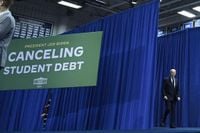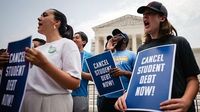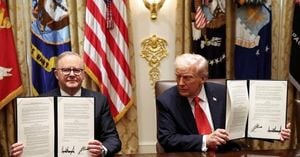Millions of Americans burdened by student debt have received a rare dose of good news after the Trump administration agreed to resume and expand student loan forgiveness for borrowers enrolled in specific federal repayment plans. The breakthrough came on October 17, 2025, following a months-long legal battle led by the American Federation of Teachers (AFT), and is poised to deliver long-awaited relief to an estimated 2.5 million people.
The deal, reached between the Trump administration and the AFT, requires the U.S. Department of Education to process loan forgiveness for borrowers in Income-Driven Repayment (IDR) plans, Income-Contingent Repayment plans, Pay As You Earn (PAYE), and the Public Service Loan Forgiveness (PSLF) program. According to the Associated Press, the agreement also ensures that those who have made payments beyond what was needed for forgiveness will be reimbursed, and that balances forgiven before December 31, 2025, will not be treated as taxable income—a crucial detail, since forgiven debt will become taxable in 2026 due to a recent change in tax law.
"We took on the Trump administration when it refused to follow the law and denied borrowers the relief they were owed," said AFT President Randi Weingarten in a statement quoted by Nexstar Media. "Our agreement means that those borrowers stuck in limbo can either get immediate relief or finally see a light at the end of the tunnel. And, crucially, they won’t ever get taxed on that relief." She added, "AFT will hold the federal government to its word, and we won’t stop fighting until college is affordable and taking out a student loan doesn’t trap millions of Americans in a ruinous and exploitative debt cycle."
The roots of the dispute stretch back to a pause in student loan forgiveness under multiple income-driven repayment plans, a move triggered by a separate legal battle in the courts. The Education Department noted, "The Biden Administration’s illegal attempts at mass student loan forgiveness impacted all of the Department’s income-driven repayment programs, including Income-Based Repayment. The courts intervened to stop their illegal efforts but that also impacted Department systems and prevented us from processing lawful loan discharges." The department continued, "Thanks to the Trump Administration’s efforts to separate out the illegal loan cancellation schemes, we are able to process legitimate loan cancellations once again for borrowers who have been making payments for the requisite number of years."
The agreement has a wide reach: an estimated 2.5 million borrowers in IDR plans will be affected, along with another 70,000 waiting for forgiveness through the PSLF program. For those in the PSLF program—which has existed since 2007 and offers forgiveness to borrowers working in non-profits or public service after 120 qualifying payments or ten years—there’s an added benefit. The Biden administration had created an option in 2023 for borrowers to "buy back" months of payments missed during forbearance or deferment, allowing more people to qualify for forgiveness. Under the new agreement, the Education Department will continue to process these "buyback" applications, a move that advocates say could be life-changing for public servants who have struggled with the program’s notorious complexity.
Winston Berkman-Breen, legal director for Protect Borrowers, the group that represented AFT and others in court, highlighted the importance of transparency and accountability in the deal. "It’s a really important accomplishment last week, but really, what it does is it tees us up to make sure that there’s transparency and court oversight as the Department of Education and the Trump administration start to deliver on what they promised," Berkman-Breen told Nexstar Media. He added, "We’re really going to stay vigilant, and part of the agreement was to, once the government resumes, once the shutdown is over, file monthly status reports and updates with the court on the progress of their commitment. How many people are getting their loans canceled, how many people are in the queue to get their loans canceled, etc., and so we’ll be monitoring that over the next few months, and hopefully things go well, but if they don’t go well, we still have our case live in court and we’ll go back to the judge to get relief."
The Trump administration, for its part, said it is reviewing forgiveness programs to identify those not affected by court rulings that blocked much of the Biden administration's efforts to cancel student debt. "The Administration looks forward to continuing its work to simplify the student loan repayment process through implementation of the President’s One Big Beautiful Bill Act," the Education Department said in a statement to the Associated Press. Under the terms of the agreement, the department must file progress reports every six months with the court to show the pace of application processing and loan forgiveness.
Borrowers who continue to make payments while their application is pending forgiveness can expect refunds if they are successful, according to Megan Walter, a senior policy analyst at the National Association of Student Financial Aid Administrators. However, she advises, "But keep really good records."
There are still complications to navigate. Advocates like Sabrina Calazans, executive director of the Student Debt Crisis Center, warn that the government shutdown—during which 95 percent of Education Department employees are furloughed—could slow down the process. "We welcome student loan cancelation and debt relief for folks, especially those who have been in repayment and have done their due diligence and these repayment plans, and it’s, it’s long overdue for a lot of these families, especially in a time of financial and economic uncertainty and during a government shutdown," Calazans told Nexstar Media. She also noted that the court order does not allow loan discharge for people enrolled in the Biden administration’s SAVE plan, so those who have made 20 years of payments are encouraged to call their loan servicer to see if they can switch to an IDR plan to become eligible.
The agreement also sets a deadline for the current structure: the Education Department will continue processing relief for borrowers in Income-Contingent Repayment and Pay As You Earn plans until these options are eliminated in 2028 under President Trump's "Big, Beautiful Bill." After that, the landscape of student loan repayment and forgiveness could change dramatically for new borrowers.
For now, however, the deal represents a significant, if hard-won, victory for millions of Americans who have spent decades paying down their student loans. The next several months will be critical, as advocates, borrowers, and the courts monitor the administration’s progress and hold it accountable to its promises. As the dust settles, many are hoping this marks a turning point in the often-turbulent history of student loan forgiveness in the United States.






